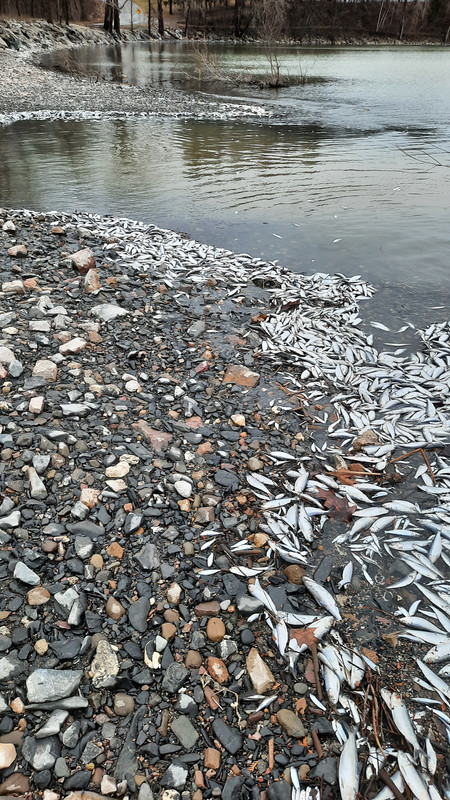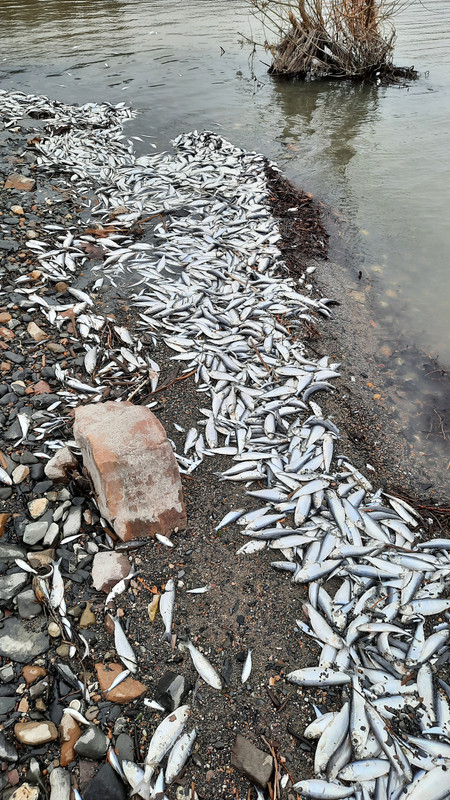Page 1 of 1
IS Alewives 3-3024
Posted: Thu Mar 07, 2024 11:01 am
by rockntroll
Keeping the birds busy.


Re: IS Alewives 3-3024
Posted: Thu Mar 07, 2024 11:42 am
by Reelax
Sad that used to be bait for salmon to eat. Now it’s fertilizer!
Thanks for sharing…
Re: IS Alewives 3-3024
Posted: Fri Mar 08, 2024 6:42 pm
by steve
I saw that a few year back. In the inland sea.... But not this early.
Re: IS Alewives 3-3024
Posted: Fri Mar 08, 2024 6:50 pm
by Mistress
Alewives do not tolerate big temperature changes and not being native to Champlain a large amount die off in the winter, get trapped under the ice and wash ashore when the ice breaks up. I remember a bulletin F&W put out a few years back, will try to find it and post it.
Re: IS Alewives 3-3024
Posted: Fri Mar 08, 2024 6:55 pm
by Mistress
R Lake Champlain Alewife Die-off
Press Releases
Tue, 04/16/2019 - 12:00
Large numbers of small fish called alewives are washing up on the shores of Lake Champlain in Milton and Georgia. State fisheries biologists from the Vermont Fish & Wildlife Department say it is an example of the kind of problems non-native invasive fish species can cause.
First documented in Lake Champlain in 2005, alewives are now well established and found throughout the lake.
"Unfortunately, dead alewives washing up on the shores of Lake Champlain following a winter die-off has become a common occurrence," said State Fisheries Biologist Shawn Good. “Alewives are an invasive fish species native to the Atlantic Ocean, and they are not well adapted to winters in freshwater lakes such as Lake Champlain. They are highly susceptible to fluctuations in water temperature that occur in the winter and are easily killed when this happens."
Good says dead alewives tend to stay preserved for long periods of time in cold water, but as ice cover melts in the spring, they wash up on shore in large numbers.
"Invasive fish species like alewives can have many negative repercussions to our native fish communities, as well as impacting the general public when large die-offs occur like we’re seeing again this spring,” said Good. “The movement and introduction of fish from one water to another, whether accidental or purposeful, is illegal and can threaten Vermont’s aquatic ecosystems and the fishing opportunities they provide.
Good says while some anglers may think introducing a new fish species to their favorite lake or pond will provide a new fishing opportunity or provide food for game fish already inhabiting the waterbody, the reality is that non-native fish introductions almost always have unwanted, negative consequences.
"The great fishing we enjoy today could be gone tomorrow if aquatic nuisance fish species are allowed to spread," he cautioned. “We all need to work together to slow or prevent the spread of exotic species and protect Vermont’s native fish and the fishing opportunities they provide.”
For Immediate Release: April 16, 2019
Media Contacts: Shawn Good, 802-786-3863; Bernie Pientka 802-879-5698
Re: IS Alewives 3-3024
Posted: Sat Mar 09, 2024 11:35 am
by Gecha (Gerry)
Sad to see that die-off. But I guess that is part of nature.
Re: IS Alewives 3-3024
Posted: Sun Mar 17, 2024 9:40 am
by tmcaul
I think I am right when I say that the Great Lakes salmonid fishery came about when salmonids (salmon, brown trout, and steelhead) were introduced to predate the alewives that had arrived via the St. Lawrence Seaway. Now the estimation of the alewife population drives the stocking plan for salmonids. (At least in some of the Great Lakes.) So it would be logical to imagine that a big salmon or trout from Champlain might crack the 20 lb. weight which is somewhat common in Lake Ontario. (Yes, I have read that the really big fish coming out of Ontario are declining in weight.) Lake trout out of Champlain seem to be trending "heavier". But I don't see that for our other salmonids. Why? Your thoughts invited.
Re: IS Alewives 3-3024
Posted: Sun Mar 17, 2024 5:08 pm
by Reelax
tmcaul wrote: ↑Sun Mar 17, 2024 9:40 am
I think I am right when I say that the Great Lakes salmonid fishery came about when salmonids (salmon, brown trout, and steelhead) were introduced to predate the alewives that had arrived via the St. Lawrence Seaway. Now the estimation of the alewife population drives the stocking plan for salmonids. (At least in some of the Great Lakes.) So it would be logical to imagine that a big salmon or trout from Champlain might crack the 20 lb. weight which is somewhat common in Lake Ontario. (Yes, I have read that the really big fish coming out of Ontario are declining in weight.) Lake trout out of Champlain seem to be trending "heavier". But I don't see that for our other salmonids. Why? Your thoughts invited.
As far as salmon go, I think the record will be broken again soon. We just need to get them to live long enough. It is great to see a LARGE supply of 1 year lake salmon right now. We have not seen this many in recent years..IMHO. 2 years from now these will be hogs and 3 years from now if there are any left they will push trophy proportions. I think we are on and
up swing and as long as the lake level stays high, we will be happy for a couple years!!!! Booo yaaa.
If it’s due to these Alwives, they are welcome in my mind:)
Re: IS Alewives 3-3024
Posted: Mon Mar 25, 2024 6:32 pm
by tmcaul
From Lake Michigan and Chicago, my hometown. Post alewife invasion and post salmonid stocking, this is what the fishery now offers. From shore!
https://www.youtube.com/watch?v=OjvrRLkYVnc&t=665s